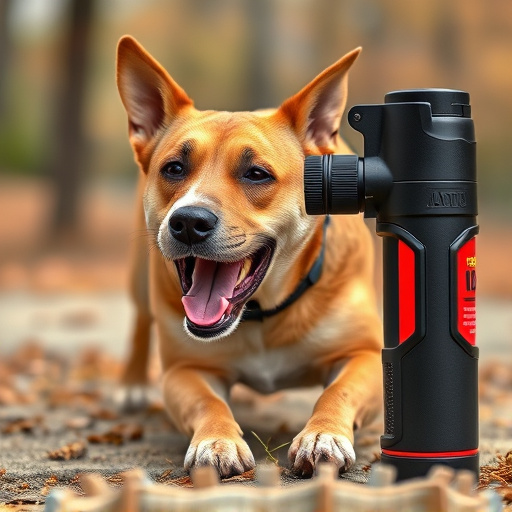Dog deterrent spray, like canine pepper spray, uses capsaicin irritants to temporarily disable and deter aggressive dogs. Effective deployment requires understanding a 3-meter (10-foot) reach and aiming for sensitive areas. The Canine Pepper Spray Deployment Distance Guide offers critical insights on optimal spray range for maximum effectiveness, safety, and responsible usage by pet owners and professionals. Safety should always be prioritized when using these sprays, with precise aiming, proper storage, regular maintenance, and limited application to avoid desensitization or unnecessary stress.
“Unravel the power of dog deterrent spray—a non-lethal, effective solution for managing canine behavior. Our comprehensive guide delves into the science behind these sprays, focusing on key ingredients and their impact. We’ll break down the essential elements, offering insights into their effectiveness and how to optimally deploy them, as per the Canine Pepper Spray Deployment Distance Guide. Additionally, we’ll explore critical safety measures and responsible usage practices.”
- Understanding Dog Deterrent Spray: The Basics
- Key Ingredients and Their Effectiveness
- How to Calculate Deployment Distance
- Safety Precautions and Responsible Use
Understanding Dog Deterrent Spray: The Basics
Dog deterrent spray is a non-lethal solution designed to temporarily incapacitate or discourage canine aggression without causing serious harm. It works by delivering a powerful stream of irritants, usually capsaicin (derived from chili peppers), directly into the dog’s eyes and nose. This immediate sensory overload disrupts their behavior, allowing for safe de-escalation and retreat. The key to effective deployment is understanding the spray’s range and application technique – a vital Canine Pepper Spray Deployment Distance Guide.
When using dog deterrent spray, it’s crucial to know that its reach typically extends up to 3 meters (10 feet), depending on the model and environmental conditions. For best results, aim for the face – eyes and nostrils are sensitive areas – and move quickly to create a safe space before the spray dissipates. Regular training and practice in controlled settings can ensure you’re prepared should an encounter arise, allowing you to effectively navigate potentially dangerous canine interactions with minimal stress for both you and the dog.
Key Ingredients and Their Effectiveness
When it comes to dog deterrent sprays, understanding the key ingredients and their effectiveness is crucial. Active ingredients like capsicum, a natural compound derived from chili peppers, are known for their ability to cause a burning sensation when in contact with mucous membranes—a reaction that can quickly deter canine intruders. This component is often combined with other agents like citric acid and essential oils, which enhance its persistence and create an unpleasant experience without causing harm.
The deployment distance of canine pepper spray is another critical factor. Formulas designed for longer-range applications typically incorporate more volatile ingredients to ensure quick dispersion, reaching unwanted visitors before they get too close. These sprays can be particularly effective in large outdoor areas or as a last resort when other deterrents have failed. The Canine Pepper Spray Deployment Distance Guide offers valuable insights into the ideal spray range for maximum effectiveness, ensuring pet owners and professionals alike use these tools responsibly and safely.
How to Calculate Deployment Distance
Calculating the deployment distance for canine pepper spray is a crucial step in ensuring its effectiveness and safety. This process involves understanding your specific environment, including factors like terrain, wind conditions, and the behavior of the target dogs. Start by assessing the area where you’ll be using the spray; consider open spaces versus narrow alleys or parks with tall vegetation. Wind direction and speed are also critical factors—a calm day is ideal for precise deployment, while a windy one may require adjusting the distance to prevent the spray from blowing back towards you or nearby civilians.
Next, consider the range of motion and reach of the sprayer. Different models offer varying distances, so check the manufacturer’s guidelines. For instance, a Canine Pepper Spray designed for law enforcement use might have a suggested deployment distance of 15-20 meters, while one intended for personal protection may be more suitable for closer ranges, around 5-10 meters. Always test the spray in controlled conditions to gauge its reach and ensure it covers the desired area effectively.
Safety Precautions and Responsible Use
When considering the use of dog deterrent spray, safety precautions are paramount. Canine pepper spray, also known as dog deterrents, is designed to temporarily incapacitate or disrupt a dog’s behavior, but it should be used responsibly and with caution. Always follow the manufacturer’s instructions for deployment distance; typically, these sprays have a suggested range of 3 to 10 feet (a common Canine Pepper Spray Deployment Distance Guide). It’s crucial to aim carefully, ensuring you hit the target area without endangering bystanders or pets.
Proper storage and handling are essential. Keep the spray out of reach of children and pets, in a secure, locked cabinet if possible. Regularly check expiration dates, as these products have a limited shelf life. Additionally, familiarize yourself with local laws regarding the use and possession of dog deterrents, as regulations can vary widely. Responsible use includes only deploying the spray when necessary, as over-reliance may desensitize dogs to the scent or cause unnecessary stress for both the animal and its owner.
Dog deterrent spray, particularly canine pepper spray, offers a safe and effective solution for managing unwanted canine behavior. By understanding the key ingredients, deployment distance, and safety precautions outlined in this guide, you can responsibly utilize this tool to protect your space. Remember, proper use and knowledge are essential to ensuring its effectiveness while keeping both dogs and humans safe.
